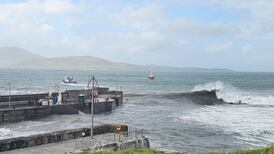Young Henry Cooke had some unusual teachers in Co Derry in the 1790s. There was Joseph Pollock, a tall Scot with an enormous nose and black horned-rimmed spectacles whose hazel rod made his pupils tremble but who taught Catholics, Protestants and Presbyterians their respective catechisms with equal determination.
Then there was Frank Glass, reputedly an ardent rebel, who swore at the children but was an excellent teacher of the classics. Cook travelled the four miles between his home in Grillagh near Maghera and Glass’s cottage daily for two years and learned sufficient Latin to matriculate in Glasgow University in 1802 when he was just 14 years old.
To reach the university, he walked 60 miles to Donaghadee, crossed to Portpatrick in the weekly mail packet and walked a further 80 or more miles to the city.
It was a journey he would make annually for the next five years.
He didn’t graduate, due to illness, but after attending a theology course at the university’s Divinity Hall he was ordained by the presbytery of Ballymena in the Synod of Ulster.
Cooke’s outlook was primarily influenced not by his teachers in Derry or Glasgow but by his mother a determined opponent of the Arian, Unitarian and liberal “new light” strands of Presbyterianism that rejected the doctrine of the Trinity or left belief optional, and by the political and civil turbulence he had witnessed as a child.
Strict adherence to the Westminster Confession of Faith, adopted by Church of Scotland in 1647, and loyalty to the Crown would be the guiding principles of his life.
After appointments in Duneane and Donegore, Co Antrim, he moved to Killyleagh, Co Down in 1818.
By now he was recognised as a minister of ability and a superb orator and, when an English Unitarian, John Smethurst, visited Ulster, Cooke debated with him repeatedly and was considered the victor.
In 1824, when he was elected moderator of the Synod, he attacked the Belfast Academical Institution which now trained candidates for ministry as a “seminary of Arianism”. In 1825, he convinced individual presbyteries to examine the orthodoxy of candidates for ministry and in 1836 unqualified subscription to the Westminster Standards became compulsory.
Meanwhile, in 1829, seventeen congregations and ministers including his great rival, Hugh Montgomery, decided that they could no longer be members of the synod and after issuing a “remonstrance” they withdrew.
In November of that year, Cooke was installed in a new church in May Street, Belfast. Although he had to resign as pastor on becoming professor of sacred rhetoric in the college of the new General Assembly of the Presbyterian Church in 1847, he continued to preach there almost until his death.
The passage of the Catholic Emancipation Act, soon followed by Daniel O’Connell’s alliance with the Whigs, was seen by many Protestants and Presbyterians as a threat to their standing but Cooke was the first to act on their fears.
At a meeting of more than 30,000 people at Hillsborough on October 30th, 1834, the Presbyterian son of a nine-acre tenant farmer shared a platform with the Church of Ireland Marquis of Downside, the largest landowner in the county, and proclaimed “the banns of a marriage between the reformed churches, a sacred marriage of Christian forbearance where they differ, of Christian love where they agree and of Christian co-operation in all matters where their common safety is concerned”. The notion was opposed by some Presbyterians but the idea took root.
Many of the earlier fears were renewed in 1840, the year O’Connell decided to bring his campaign to repeal the Union to Ulster.
Cooke challenged him to a debate but he declined and resorted to bombast calling the minister “Bully Cooke, the Cock of the North”.
He still visited Belfast, early in 1841, but only for four days and didn’t risk a public meeting. On January 19th he left for Donaghadee under armed escort to sail to Scotland.
Two days later, Cooke issued another challenge, this time to a crowd in the city’s Carlisle Circus: “Look at Belfast, a glorious sight, the masted groves in the harbour, the mighty warehouses, the giant manufactories, the rapidly growing streets, all owed to the Union. Look at Belfast and be a repealer if you can”.
According to contemporaries, Cook “dished” (ie defeated) Dan and repulsed the repealer.
To his detractors, he was imperious, a Presbyterian pope; to his co-religionists, he was the outstanding minister of his time, and in wider Irish history he was the progenitor of the alliance that would unite Ulster Protestants of all classes and persuasions when the prospect of Home Rule emerged in the 1880s.
After he died, on December 13th, 1868, his funeral was the largest ever seen in the city.
Later, his friends commissioned FS Lynn to sculpt a statue in his memory. It was unveiled outside the Institute in March 1876 on a spot where a statute of an earl of Belfast, known as the Black Man, had formerly stood. The name still applies to Cooke’s statue even though oxidation has given it a greenish tinge.









